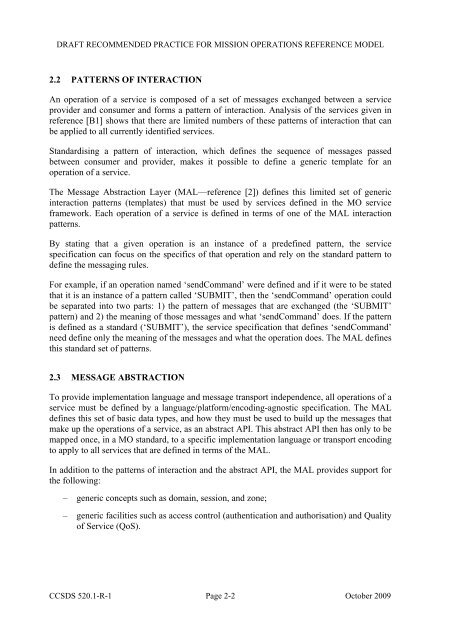Mission Operations Reference Model. Draft ... - CCSDS
Mission Operations Reference Model. Draft ... - CCSDS
Mission Operations Reference Model. Draft ... - CCSDS
You also want an ePaper? Increase the reach of your titles
YUMPU automatically turns print PDFs into web optimized ePapers that Google loves.
DRAFT RECOMMENDED PRACTICE FOR MISSION OPERATIONS REFERENCE MODEL2.2 PATTERNS OF INTERACTIONAn operation of a service is composed of a set of messages exchanged between a serviceprovider and consumer and forms a pattern of interaction. Analysis of the services given inreference [B1] shows that there are limited numbers of these patterns of interaction that canbe applied to all currently identified services.Standardising a pattern of interaction, which defines the sequence of messages passedbetween consumer and provider, makes it possible to define a generic template for anoperation of a service.The Message Abstraction Layer (MAL—reference [2]) defines this limited set of genericinteraction patterns (templates) that must be used by services defined in the MO serviceframework. Each operation of a service is defined in terms of one of the MAL interactionpatterns.By stating that a given operation is an instance of a predefined pattern, the servicespecification can focus on the specifics of that operation and rely on the standard pattern todefine the messaging rules.For example, if an operation named ‘sendCommand’ were defined and if it were to be statedthat it is an instance of a pattern called ‘SUBMIT’, then the ‘sendCommand’ operation couldbe separated into two parts: 1) the pattern of messages that are exchanged (the ‘SUBMIT’pattern) and 2) the meaning of those messages and what ‘sendCommand’ does. If the patternis defined as a standard (‘SUBMIT’), the service specification that defines ‘sendCommand’need define only the meaning of the messages and what the operation does. The MAL definesthis standard set of patterns.2.3 MESSAGE ABSTRACTIONTo provide implementation language and message transport independence, all operations of aservice must be defined by a language/platform/encoding-agnostic specification. The MALdefines this set of basic data types, and how they must be used to build up the messages thatmake up the operations of a service, as an abstract API. This abstract API then has only to bemapped once, in a MO standard, to a specific implementation language or transport encodingto apply to all services that are defined in terms of the MAL.In addition to the patterns of interaction and the abstract API, the MAL provides support forthe following:– generic concepts such as domain, session, and zone;– generic facilities such as access control (authentication and authorisation) and Qualityof Service (QoS).<strong>CCSDS</strong> 520.1-R-1 Page 2-2 October 2009
















